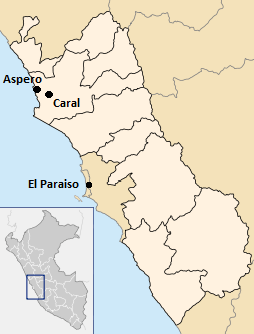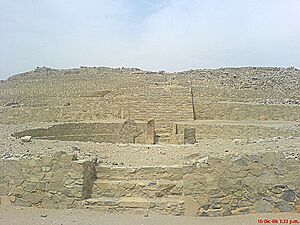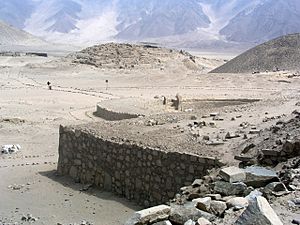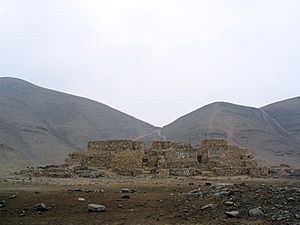Andean preceramic facts for kids
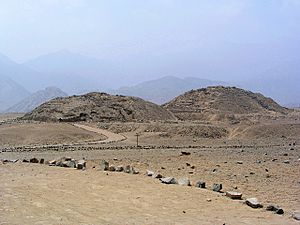
The Andean preceramic period is about the first people who lived in the Andes mountains in South America. This was a long time ago, before people learned how to make pottery (ceramics). So, "preceramic" means "before pottery."
Contents
First People in the Andes
The very first humans who came to South America are called Paleo-Indians. They were hunters and gatherers. This early time is often called the Lithic stage. After that came the Archaic period. During these times, people learned new ways to live and use tools. The Andean preceramic period includes these early groups of people.
Ancient Peru: Before Pottery
Many important discoveries about preceramic cultures have been made in Peru. For example, in the Zaña Valley in northern Peru, archaeologists found the oldest known canals in South America. These small canals, built around 4700 BC, brought water from the Andes Mountains.
Caral/Norte Chico Civilization
The Caral/Norte Chico civilization is one of the most amazing ancient cultures in Peru. They built huge structures like large platform mounds (like pyramids) and round, sunken plazas. These people also created advanced systems to manage water and irrigate their farms.
They were very skilled with textiles, especially cotton. Recent studies show that maize (corn) was an important crop for them as early as 3000 BC. They also grew beans and sweet potatoes.
The Caral/Norte Chico sites are special because so many large settlements were built close together. Some experts believe this area was one of the most crowded places in the world around 2500 BC. Several river valleys, like the Supe, Pativilca, Fortaleza, and Huaura, had many related sites.
Caral City
Caral was a very important city in this civilization. People lived there between 2600 and 2000 BCE. The city covered a large area, more than 60 hectares.
Archaeologists, led by Dr. Ruth Shady Solís, first fully studied Caral in the late 1990s. Their discoveries showed how important the Norte Chico civilization was. It proved that complex societies existed in Peru much earlier than people thought, over a thousand years earlier.
Huaricanga
Huaricanga, also in the Norte Chico region, might be the oldest city of this civilization. This would make it the oldest city in all of the Americas, existing around 3500 BCE.
One interesting thing about this civilization is that archaeologists haven't found much art or religious symbols. However, there is some evidence that they worshipped certain gods, like the Staff God. This god, with a hood and fangs, was important in later Andean cultures too. This suggests that some religious ideas lasted for a very long time.
The Caral/Norte Chico civilization must have had a very organized government to manage such large projects. Experts are still learning about how their society was run. At first, some thought their society was based mostly on seafood. But now, with strong evidence of corn farming, those ideas are changing.
Casma and Sechin Rivers
Many important preceramic sites are found in the valleys of the Casma River and Sechin River. Some of the largest sites include Sechin Alto, Sechin Bajo, Mojeque, Cerro Sechin, and Las Haldas. These sites date back to around 3600 BCE.
Kotosh Religious Tradition
The Kotosh Religious Tradition describes special ritual buildings built in the mountain areas of the Andes. These were constructed between about 3000 and 1800 BCE, during the Andean preceramic period.
Archaeologists have found several of these ritual centers. The first one was discovered at Kotosh. Other similar sites include Shillacoto, Wairajirca, Huaricoto, La Galgada, and Piruru. Even though these sites are far apart, their public buildings look very similar.
Other Peruvian Sites
El Paraiso is a very large early center in the Ancón-Chillón Valley. It is from about the same time as the Norte Chico civilization. It is one of six major preceramic sites in that valley, which also includes Ancon (archaeological site).
Another important site is Bandurria, Peru, on the Huaura River. It has large buildings that might be from the mid-fourth millennium BC.
On the northern Peruvian coast, sites like Huaca Prieta are famous. The oldest known use of indigo dye was found there. At Huaca Ventarron, painted murals are the oldest discovered in the Americas.
Ancient Ecuador: Before Pottery
In Ecuador, the Preceramic period began around 9000 BC and lasted until about 4200 BC. There is a lot of evidence of early settlements in the highlands of Ecuador.
Along the Pacific Coast, the Las Vegas culture was important. In the mountains, it was the Inga culture.
The Las Vegas culture was the first known culture in Ecuador. They lived on the Santa Elena Peninsula between 9000–6000 BC. These people were hunters, gatherers, and fishermen. Around 6000 BC, they were among the first to start farming. They grew bottle gourds and an early type of maize (corn).
The El Inga people lived high in the mountains near modern-day Quito. Evidence from the El Inca site dates this culture to 9000–8000 BC. This area is very important for understanding South American history.
Ancient Colombia: Before Pottery
El Abra is a key early human settlement in Colombia. It has a large cave system. Studies there began in 1967. Tools, bones, and charcoal found there show that people lived there around 12,400 years ago. Other preceramic sites in Colombia include Tibitó (11,850 years ago), Tequendama (11,000 years ago), Checua (8500 years ago), Aguazuque (5000 years ago), and El Infiernito (4900 years ago).
Ancient Bolivia: Before Pottery
The earliest cultures in Bolivia were the Wankarani culture and the Chiripa. The first Wankarani sites date from 1800 BC. This culture grew near Lake Poopo in Bolivia. By 1200 BC, the Wankarani had started working with copper.
The area near Lake Titikaka in Bolivia has the earliest proof of metalworking in South America. At a site called Jisk'a Iru Muqu, archaeologists found a necklace with nine gold beads. These gold beads are from around 2155-1936 BC.
Ancient Chile: Before Pottery
Some early preceramic cultures lived in both Peru and Chile. One example is the Chinchorro culture. They lived in what is now northern Chile and southern Peru. The Chinchorro culture is famous for its Chinchorro mummies. These are the oldest examples of artificially mummified human remains in the world. The oldest mummy found in the Atacama Desert is from around 7020 BC. This tradition was most active around 3000 BC.
|
See also
 In Spanish: Precerámico andino para niños
In Spanish: Precerámico andino para niños


